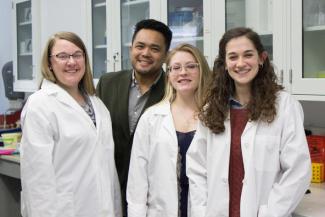Wonder Women: Young Scientists Help Confirm Presence of Breathing "Ghost Network"

According to a paper recently published in Cell Reports, labs from Case Western Reserve and the University of Kentucky's Spinal Cord and Brain Injury Research Center (SCoBIRC) were able to demonstrate the existence of a parallel neural network that could potentially restore diaphragm function after spinal cord injury.
This ghost network operates entirely separate from the brain, which has long been considered the only organ capable of directing respiratory function, and appears able to instruct the diaphragm to contract when properly activated.
While practical solutions are a long way away, the implications of this research for quadriplegics, many of whom rely on a respirator to breathe, are enormous. Constant mechanical ventilation increases the risk of fatal infection, which is the leading cause of death for spinal cord injury patients. Reducing reliance on ventilators would go a long way towards improving quality and longevity of life for those with devastating spinal cord injuries.
But perhaps more amazing is that this research is credited to a group of young scientists – one not yet graduated from college.
Warren Alilain heads the lab at SCoBIRC where Rachel Maggard, Lydia Hager and Daimen Stoltz work. Alilain has long been researching combination therapies to restore breathing function to patients with older cervical spinal cord injuries.
"Jared Cregg and Jerry Silver [my colleagues at Case Western] have been looking into ways to restore diaphragm function after spinal cord injury for a while, and their research uncovered this latent network in neonatal mice about two years ago," Alilain said. "The initial neonatal results from Case Western were intriguing, but since most spinal cord injuries occur in adults, it was an important step to replicate the results in adult rats, and Jared knew my lab had the appropriate experience."
So Cregg reached out to Alilain for help. Alilain collected his lab group together, mapped out the proposal from Case Western, and then asked, "Who wants to do it?"
Maggard and Hager, both first-year graduate students, and Stoltz, a college senior, looked at each other and thrust their hands in the air.
So, for three weeks last summer, the women duplicated Cregg's experiments using adult rats and were able to confirm the presence of the ghost network.
And then Cell Reports came knocking.
All three women call the experience of having a manuscript accepted for a major publication at such a tender age "surreal."
"It's a huge career boost," said Hager, who credits Alilain's unwavering support and guidance both in and out of the lab for their success, with an enthusiastic chorus of seconds from Maggard and Stoltz.
In a moment reminiscent of a meeting of the Mutual Admiration Society, Alilain protests, saying that the credit belongs entirely to this group of bright young scientists.
"Warren has high expectations of us but he also helps us get there," said Stoltz, who will receive her undergraduate degree this spring. "He brought us along to several national neuroscience meetings – a rare opportunity for someone my age – and taught us that science is about more than working in a lab."
Maggard agreed with Stoltz, adding that being with Alilain at scientific meetings was like following a rock star around.
"Warren showed us that networking and sharing ideas were all critical elements of good science," Maggard said.
Hager, Maggard and Stoltz also praise UK for the research opportunities it affords students.
"I was surprised at how many undergrads get to do lab work here," Hager said. "They have their own projects, just like graduate students," which gives them a leg up on their training.
Maggard called the sheer abundance of research opportunities at UK mind boggling. "It's like an all you can eat buffet -– there's plenty of opportunity for those who look for them."
University of Kentucky Vice President for Research Lisa Cassis has long advocated for an inclusive and collaborative research environment, encouraging senior principal investigators to invest in one-on-one mentoring for students of all genders and at all levels.
"People generally think of a researcher as a gray-haired gentleman in a white lab coat, but more and more we are seeing that younger people – both men and women – are the new face of research," Cassis said.
Cassis explained that the collegial nature of research at UK has fostered an environment where scientists feel comfortable sharing their ideas and techniques with each other and with students, noting that UK even gives financial incentives to units that collaborate with one another.
"That sense of community trickles down to the younger scientists and even our students, who learn that teamwork helps us stay competitive. Many universities do not have that culture – some places are so competitive that it's taboo to walk into someone else's lab – and that's a real barrier to student learning."
Next up for Alilain's group: looking for clinically relevant ways to activate this latent breathing network to mimic normal breathing rhythm in people with spinal cord injuries. "This is always the hardest challenge: taking knowledge gleaned from the bench and successfully applying it to the human condition," Alilain said.
But he – and the next generations of scientists who benefit from the early opportunities afforded them at UK -- are up to the task.




